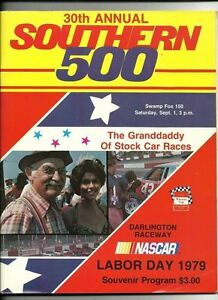|
1979 Southern 50034°17′50.5″N 79°54′18.4″W / 34.297361°N 79.905111°W
The 1979 Southern 500, the 30th running of the event, was a NASCAR Winston Cup Series race that took place on September 3, 1979, at Darlington Raceway in Darlington, South Carolina. This would be the last race without Dale Earnhardt until 2001 Dura Lube 400, and the last in not featuring the name Earnhardt on the starting grid until the 2012 Bank of America 500. BackgroundDarlington Raceway, nicknamed by many NASCAR fans and drivers as "The Lady in Black" or "The Track Too Tough to Tame" and advertised as a "NASCAR Tradition", is a race track built for NASCAR racing located near Darlington, South Carolina. It is of a unique, somewhat egg-shaped design, an oval with the ends of very different configurations, a condition which supposedly arose from the proximity of one end of the track to a minnow pond the owner refused to relocate. This situation makes it very challenging for the crews to set up their cars' handling in a way that will be effective at both ends. The track is a four-turn 1.366 miles (2.198 km) oval.[3] The track's first two turns are banked at twenty-five degrees, while the final two turns are banked two degrees lower at twenty-three degrees.[3] The front stretch (the location of the finish line) and the back stretch is banked at six degrees.[3] Darlington Raceway can seat up to 60,000 people.[3] Darlington has something of a legendary quality among drivers and older fans; this is probably due to its long track length relative to other NASCAR speedways of its era and hence the first venue where many of them became cognizant of the truly high speeds that stock cars could achieve on a long track. The track allegedly earned the moniker The Lady in Black because the night before the race the track maintenance crew would cover the entire track with fresh asphalt sealant, in the early years of the speedway, thus making the racing surface dark black. Darlington is also known as "The Track Too Tough to Tame" because drivers can run lap after lap without a problem and then bounce off of the wall the following lap. Racers will frequently explain that they have to race the racetrack, not their competition. Drivers hitting the wall are considered to have received their "Darlington Stripe" thanks to the missing paint on the right side of the car. Race reportThree hundred and sixty seven laps were completed on a spanning 1.366 miles (2.198 km) for a grand total of 501.3 miles (806.8 km).[2] The total time of the race was three hours, fifty-eight minutes, and fourteen seconds. Speeds were: 126.259 miles per hour (203.194 km/h) for the race average and 154.88 miles per hour (249.26 km/h) for the pole position speed.[2] There were nine cautions for fifty-two laps.[2] David Pearson, who was in semi-retirement and had left the Wood Brothers after a disastrous pit stop at the Rebel 500 earlier that year, was driving for Rod Osterlund as a substitute for rookie contender Dale Earnhardt, injured at the Pocono race, defeated Bill Elliott by two laps and four seconds.[2][4][5] This was David Pearson's first win in a General Motors car since he won the 1961 Dixie 400 in a Pontiac and the first of just two for him at the wheel of a Chevrolet. Pearson's victory also marked the last of only nine starts for David Pearson in 1979.[2] While he wasn't a familiar sight on the track this season the Silver Fox was still selected by fans as the Cup Series' Most Popular Driver at year's end. Ironically this was only time in Pearson's career he won that honor.[2] This would be one of the final races in NASCAR history that a racing car without a visible sponsor won.[2] In today's NASCAR, most drivers have a primary sponsor and a secondary sponsor due to the amount of money spent on racing components in a given season. Sixty thousand people came to watch this live event.[2] Darrell Waltrip had controlled the race until late-race incidents that dropped him to 11th, which ended his shot at sweeping the track's two races. Waltrip would not be considered a good competitor at Darlington for most of his career, despite four Rebel 500 wins (1977, 1979, 1981 and 1984). He would typically dominate the early portions of the race during the 1970s before an incident would force him out of contention for the win. Those late-race incidents would later cause Waltrip to lose the 1979 championship to Richard Petty.[4][5] The top prize of the race was $29,925 ($125,627.37 when considering inflation).[2][4][5] The participants of this race were all American-born males. With the lone Chrysler of Ed Negre and H.B. Bailey's lone Pontiac, this was the last Cup race with eight car makes in the starting lineup.[2] Ed Negre would make his final appearance here while Billy Smith would make his only professional stock car appearance.[6] Notable crew chiefs who participated in the race were Buddy Parrott, Tex Powell, Joey Arrington, Kirk Shelmerdine, Darrell Bryant, Dale Inman, Harry Hyde, and Jake Elder.[7] Hurricane David approached the East Coast of the United States during the course of the race. The storm had made landfall in Eastern Florida while the drivers were racing. Qualifying
Withdrew from race: Jan Opperman (#96)[8] Finishing orderSection reference:[2]
† signifies that the driver is known to be deceased TimelineSection reference:[2]
Standings after the race
References
|
||||||||||||||||||||||||||||||||||||||||||||||||||||||||||||||||||||||||||||||||||||||||||||||||||||||||||||||||||||||||||||||||||||||||||||||||||||||||||||||||||||||||||||||||||||||||||||||||
